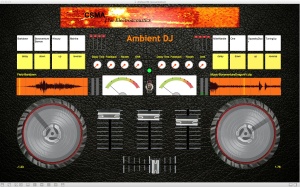I have released a new album called “Places and Traces“, so I thought I’d write some notes about it.
My working title for this album was ‘Outside2’ – a reference to my 2013 album Outside which was built upon field recordings with acoustic accompaniment or reactions. Places & Traces takes that as a starting point but goes much further with it and consequently sounds very different.
Firstly the similarities. P&T is still built upon field recordings, and they are the start of the inspiration for the music that follows. In Cavern, Enclosures and Time Goes More Slowly, they run continuously as they did in Outside, though only in Cavern does the recording run at normal speed. The titles, though less literal than on Outside are still a reference to the source of the recording.
The differences are obvious at first hearing .. this is a much more electronic album than it’s predecessor. I have used my increasing collection of hardware synthesizers to soundscape it, though there is still plenty of violin. The only acoustic violin I used is on Nowhere (for preference) which (spoiler alert) was also sampled for the speeding up part.
Track by track, this is what is happening:
Cavern
The cavern in question is Leeds City Station, though I’m also thinking of darker, more oppressive railways stations in England such as Birmingham New Street – at least how it was when I spent a depressing amount of time there in the 1980s. The bulk of the synth noises on this track were made from the same sounds I used on the CSMA track Trans-Pennine Express which passes through several stations including Leeds, but not Birmingham, obviously. Stations late at night are quite scary places when you’re a timid single female and I’ve channelled some of that foreboding into the sounds here. Taiko drums (from my E.mu World ROM) add to the terror.
Minster Yard
Minster Yard is the area around Beverley Minster, one of my favourite buildings. The bells of the Minster are used in the piece, the chimes slowed down in the first half, and re-timed a little in the second.
Nowhere (for preference)
This piece has no field recordings in it at all. The ‘nowhere’ is me staying at home, in my studio, recording instruments rather than places. Here, the acoustic violin opens with a variant on the ‘Refuge‘ theme I used in Helicopter Quartet. Home is the refuge.
Enclosures
The core if this is some field recordings I made in Northumberland on a workshop with Chris Watson & Jez Riley-French. The techniques used in this recording were both learned from those two amazing men.
Enclosures was played live at Wharf Chambers in Leeds and although I’ve labelled this version ‘(live)’ on the track list it is actually my favourite rehearsal take from when I was preparing for that gig. It features the cyborg violin controlling parameters on a Moog Minitaur from my gestures and movement – the notes were played from foot pedals. This maybe isn’t obvious from the sound I suppose but I think it makes some sort of musical sense nonetheless.
Eyespot
This is really just an excuse to use a rather nice recording I made of a Peacock at Castle Howard in North Yorkshire. … and then smother it in synths.
Stop Action
Samples here were recorded at Bradford Industrial museum. They demonstrate the huge complex weaving machines (filmed for the Helicopter Quartet Ghost Machine video) regularly and they make great sounds. The point of the title, which I’m not sure really works in the way I intended now, is that the machines are putting a lot of work into moving, but without actually achieving or making anything.
Time Goes More Slowly
The recording that runs through this was made in a pub near Ribblehead in North Yorkshire. They had a really nice clock in the corner that I recorded for quite a long time. I slowed it down to bring out the timbre of it, and that, of course, slowed down the pub conversation. The working title for this was ‘Time Travels More Slowly in the Country’ as we were in that pub, just having lunch, for about two and a half hours. The day itself was quite a leisurely one wandering around Batty Moss viaduct waiting for trains. The comment about ‘not buying any more kit’ was recorded in conversation with a man there while we were waiting. It’s slightly ironic, and obviously untrue, as there are two new synths and a sequencer on this album!
One of the things I didn’t do on this album, that I mentioned in my blog post on backing tracks, is to make music that is playable live. With the notable exception of Enclosures, which was written explicitly for a live performance, all of this music is effectively acousmatic and would need careful arranging should I decide to perform it on stage. I might make live performable pieces the subject of my next album … maybe 🙂
For info: synths used on this album are (in alphabetical order):
- Doepfer Dark Energy
- E-MU Virtuoso with World (Planet Earth) ROM.
- Moog Minitaur
- Moog Sub37
- Nord Lead A1
- Waldorf Blofeld
https://chrissie.bandcamp.com/album/places-traces
Read Full Post »


